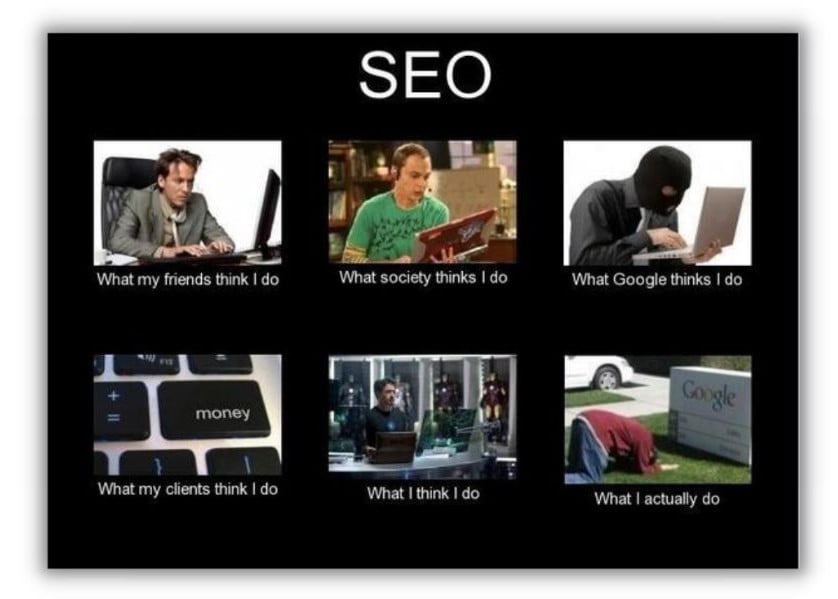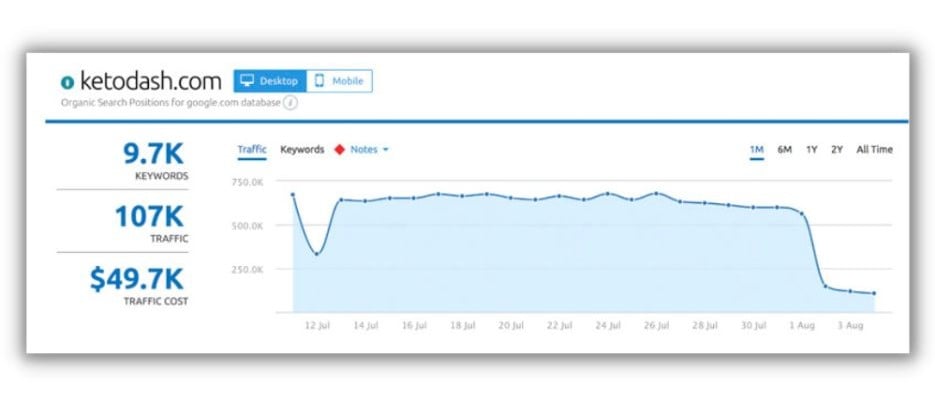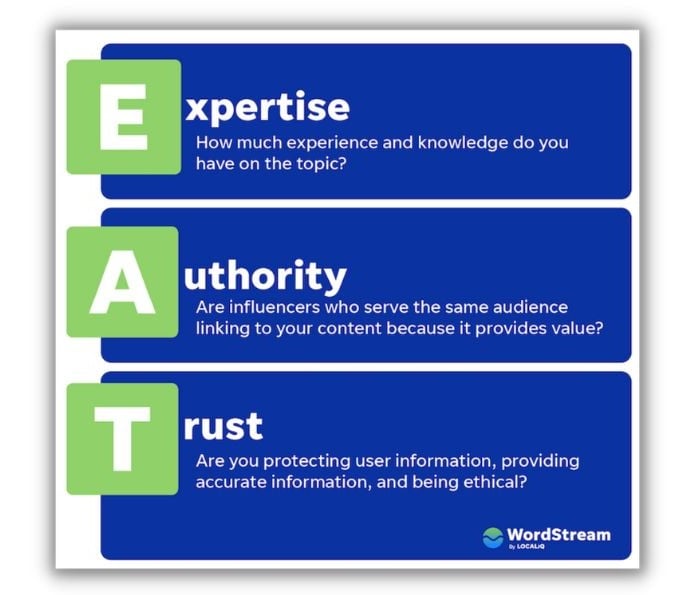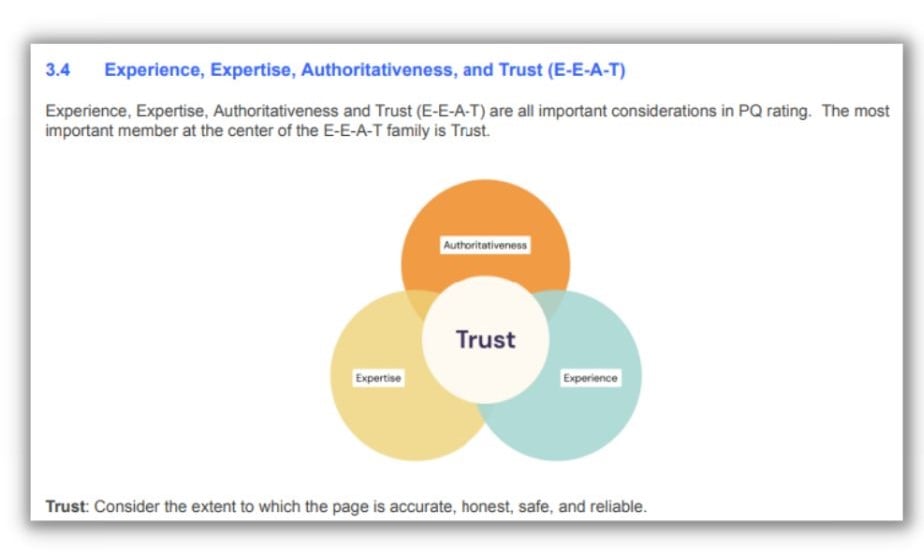Ever since Google’s Medic Update in 2018, E-A-T (Expertise, Authority, Trust) has been a hot-button topic in the world of SEO. And not just for health and medical websites, which were among the hardest hit by that update, but for all industries–SaaS, ecommerce, automotive, you name it.

Well, Google has since upped the ante, adding another “E” to create the highly intimidating acronym, “E-E-A-T.”
What exactly does that mean? And how does it impact your website’s ability to drive traffic?
Let’s dive in and see what E-E-A-T is all about.
Why should I care about E-E-A-T?
When it comes to content quality, and how pages are ranked in the SERP (search engine results page), Google has been harping on Expertise, Authority, and Trust (or E-A-T) for quite some time. In fact, we can trace the origins of E-A-T all the way back to 2014, when Google added it to their Search Quality Guidelines under a section titled “Characteristics of High Quality Pages.”
Here’s what Google said at the time about how SEOs and content creators should think about E-A-T:
“High E-A-T news articles should be produced with journalistic professionalism – they should contain factually accurate content presented in a way that helps users achieve a better understanding of events. High E-A-T news sources typically have published established editorial policies and robust review processes.”
While Google would later clarify that E-A-T was not, in fact, a ranking factor, and while Google reps would even state that the concept seemed to carry more weight in the public domain than within the company itself, the August 2018 algorithm update, called the Medic Update, specifically targeted sites that demonstrated low levels of E-A-T.
And not only targeted them but really hammered them.

Ketodash.com had low levels of E-A-T at the time of the medic update, and as a result, got dinged pretty hard.
When the Medic update hit, many in the SEO sphere realized that the sites that got hit hardest were those in the realm YMYL (Your Money or Your Life). In fact, Google had just recently updated their Search Quality Guidelines to define YMYL as:

In a nutshell, Google was making it clear that content covering topics with real-life stakes (evacuation routes for a tsunami, news about ongoing violence, information about purchasing prescription drugs, etc.) should display considerable levels of E-A-T, or risk losing rankings and traffic.

E-A-T = Expertise, Authority, and Trust
And that’s exactly what happened. This was an important distinction from Google’s continuous assertion that it looks at content quality above all when ranking content. Not that expertise was now suddenly more important than quality. But that, when YMYL content was concerned, expertise, authority, and trust would act as second layers of defense against content that appeared qualitative but came from shoddy sources.
Here’s a snapshot of the top 30 traffic losers from the Medic Update:

As you may have guessed, there are a ton of health and medical sites on this list. But it quickly became clear that while Google was singling YMYL content in its guidelines, E-A-T was something that all websites should be concerned about. Google says as much in its guidelines, explaining that there are “expert websites of all types.”

Aside from the guidelines, you can look no further than Google’s own explanation of how search engines work to see that it takes expertise deeply into account when ranking content. That means all content. Not just YMYL.
What did websites do in the wake of all this to make sure they had appropriate levels of E-A-T? It’s an important question because it sets a solid foundation for how business owners should go about auditing their websites for E-E-A-T. Let’s take a look.
How websites have traditionally approached E-A-T
As you might imagine, most, if not all of expertise, trust, and authority comes down to the person that is writing the content (meaning: the author). And in many ways, the days and months following the Medic Update saw webmasters auditing not just content quality, but author quality.
Doubling down on author expertise
How do you know if an author has credibility? Well, it’s like that old saying: you know it when you see it.
It helps if the author is an author for whom Google has created an actual entity due to their online reputation. But that doesn’t mean every person that contributes to your blog has to be Gary Vaynerchuk. It just means that they should have a demonstrable level of expertise in their subject.
So if an author has credits on other credible websites in your niche, if their names appear often in the search results, and if their posts have generated links from authoritative websites in the past: all of these things can only help your search rankings.
Doubling down on content expertise
In addition to author credibility, E-A-T also re-emphasized the importance of content quality.

And not just content quality, but content credibility. How do you know if your content itself is credible? You should:
- Sell products and services with strong reviews from real customers.
- Seek to provide content, products, and services that actually help people, not just sell them things.
- Demonstrate your expertise and credibility whenever possible. Badges, awards, reputable press–these are all things that should be openly shown and linked to on your website as much as possible.
- Make sure all content is appropriately linked and cited, and make sure those citations come from reputable sources.
So now that we’ve given you the necessary primer on how business owners have traditionally approached E-A-T, let’s talk about how E-E-A-T raises the bar (read: makes expertise even more important for more people).
How E-E-A-T raises the bar
The extra “E” in E-E-A-T stands for Experience. And this is the key way that the modern definition of E-E-A-T, which Google released in December of 2022, differs from E-A-T as we knew it.
“Experience” means that anybody can be an expert, regardless of whether or not they have a Ph.D. in their author bio. It also means that Google plans on holding content creators of all kinds to the standards they set forth in their E-A-T framework.
In a nutshell, “Experience” makes E-E-A-T a more inclusive concept in today’s creator economy. If you have bona fide first-hand experience of a subject, you too can and will be considered an expert. Here’s a succinct definition from Google’s search quality rater guidelines:
“Consider the extent to which the content creator has the necessary first-hand or life experience for the topic. Many types of pages are trustworthy and achieve their purpose well when created by people with a wealth of personal experience. For example, which would you trust: a product review from someone who has personally used the product or a ‘review’ by someone who has not?”
This is a really empowering concept for a lot of content creators. It shows Google’s awareness that in today’s digital ecosystem, great (and popular) content can be found in a variety of mediums, on a multitude of platforms, and from experts of all shapes and sizes.
It’s also a really empowering concept for brands and businesses. Does the influencer that wrote the blog for your cosmetics brand have a vast following, strong social signals, and popular content across the web? You can reap all the same benefits of E-E-A-T from that content creator that you could from the traditional “expert” with a fancy title.
The flip side of that coin is that by broadening the definition of what qualifies as expertise, Google is holding more content to higher standards of expertise. Not just YMYL. So take that to heart, and make sure whoever is creating your content, has demonstrable levels of experience, expertise, authority, and trust.
E-E-A-T doubles down on trust
Speaking of trust: that’s the other change worth noting in Google’s new E-E-A-T framework. The “T” still comes last; but, for all intents and purposes, you should consider it the most important factor in defining credible and authoritative content.
Check out this new Venn diagram Google provided:

Trust, Google says, is now the “most important member of the E-E-A-T family…because untrustworthy pages have low E-E-A-T no matter how Experienced, Expert, or Authoritative they may seem.”
They go on to elucidate what they consider the “highest E-E-A-T content, and fittingly, trust is the make-or-break component:
“Pages with High E-E-A-T are trustworthy or very trustworthy. Experience is valuable for almost any topic. Social media posts and forum discussions are often High quality when they involve people sharing their experience. From writing symphonies to reviewing home appliances, first-hand experience can make a social media post or discussion page High quality.”
To me, this is a reaction to two things. One, we live in a world of copious misinformation. Platforms, brands, and sources have been doubling down on trustworthiness for some time. Google is merely joining the party here.
And second, with the proliferation of artificial intelligence (AI), unique and trustworthy content is going to be harder to find. Not because AI is inherently untrustworthy, but because it’s now going to be easier for untrustworthy sources to create content that appears thorough, accurate, and credible, but really, has had no human input or oversight.
15 quick tips for creating high-quality E-E-A-T content
There you have it. That’s a thorough rundown of everything we know about E-E-A-T, much of it straight from Google. To close out our discussion, I’m going to give you my top 15 tips for making sure your website adheres to the search engine’s new quality standards, so you can drive valuable organic traffic for your business.
The first four of these I’ve already mentioned, but will rehash here, because I think they’re really critical:
- Sell products and services with strong reviews from real customers.
- Seek to provide content, products, and services that actually help people. I.e., don’t just sell them things!
- Demonstrate your expertise and credibility whenever possible. Badges, awards, reputable press–these are all things that should be openly shown and linked to on your website as much as possible.
- Make sure all content is appropriately linked and cited, and make sure those citations come from reputable sources.
- Solicit content from creators that have demonstrable levels of expertise, experience, authority, and trust.
- Be trustworthy above all else. Don’t publish content that in any way misleads or misguides users for the purpose of selling a product. This is all the more crucial in today’s age of information.
- Make it easy to contact you. Display your physical address, your email address, your phone number, and all other contact information prominently on your website.
- Do not blast users with intrusive interstitials and other promotional content across your website.
- Make sure content has been thoroughly researched and fact-checked before it goes on your site, from your product pages to your blog.
- Include social media profile links, website links, and bios for all of your authors.
- Demonstrate you are a real, credible company, comprised of real, credible people, selling real, credible products. A thoughtful About Us page can go a long way here.
- If you use artificial intelligence to create content, make sure it has been thoroughly humanized by a human expert within your organization.
- Use backlinks to build expertise and topical authority around subjects that are important in your niche.
- Link to credible and authoritative sources and visuals.
- Make sure that, above all, your content is original, accurate, comprehensive, and clearly communicated.
Then review these other common SEO issues to make sure you’re really getting the best out of Google.
To meet Google’s E-E-A-T guidelines, just be helpful
E-E-A-T is really a set of criteria for the people at Google who verify content quality. But it’s also a great guide for marketers to help them create content that has a better chance of landing high up on SERPs.
While there’s lots to unpack in E-E-A-T, the real takeaway is to make content that genuinely helps people. Do that, and you’ll always be on the right side of SERPs.







